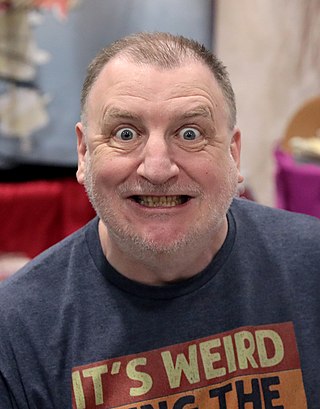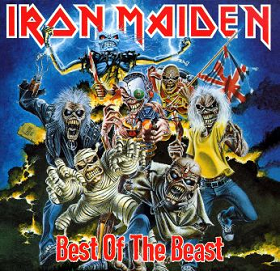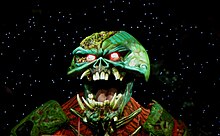
The Number of the Beast is the third studio album by English heavy metal band Iron Maiden. It was released on 22 March 1982 in the United Kingdom by EMI Records and in the United States by Harvest and Capitol Records. The album was their first to feature vocalist Bruce Dickinson and their last with drummer Clive Burr.

Iron Maiden is the debut studio album by English heavy metal band Iron Maiden, released on 14 April 1980 by EMI Records in the UK and Harvest and Capitol Records in the US. The North American version included the song "Sanctuary", released in the UK as a non-album single. In 1998, along with the rest of the band's pre-1995 releases, Iron Maiden was remastered with "Sanctuary" added in all territories. However, 2014 vinyl reissues, 2015 digital releases and 2018 CD reissues use the original track listing across the globe. It is the band's only album to feature guitarist Dennis Stratton.

Somewhere in Time is the sixth studio album by English heavy metal band Iron Maiden. It was released on 29 September 1986 in the United Kingdom by EMI Records and in the United States by Capitol Records. It was the band's first album to feature guitar synthesisers.

Seventh Son of a Seventh Son is the seventh studio album by English heavy metal band Iron Maiden. It was released on 11 April 1988 in the United Kingdom by EMI Records and in the United States by Capitol Records. Like The Number of the Beast (1982) and later Fear of the Dark (1992), The Final Frontier (2010), and The Book of Souls (2015), the album debuted at number one on the UK Albums Chart. The lead single "Can I Play with Madness" was also a commercial success, peaking at No. 3 in the UK Singles Chart.

Brave New World is the twelfth studio album by English heavy metal band Iron Maiden, released on 30 May 2000. It was their first studio release since the return of longtime lead singer Bruce Dickinson and guitarist Adrian Smith in 1999, as well as the band's first studio recording as a six-piece, as Janick Gers, who replaced Smith in 1990, remained with the band.

Maiden Japan, released as Heavy Metal Army in Japan, is a live EP by the British heavy metal band Iron Maiden. The title is a pun of Deep Purple's live album Made in Japan.

Fear of the Dark is the ninth studio album by English heavy metal band Iron Maiden. Released on 11 May 1992, it was their third studio release to top the UK Albums Chart, and the last to feature Bruce Dickinson as the group's lead vocalist until his return in 1999.

No Prayer for the Dying is the eighth studio album by English heavy metal band Iron Maiden. It is their first album to feature Janick Gers on guitar, who replaced Adrian Smith. Smith left the band during the pre-production phase, unhappy with the musical direction it was taking, and only having contributed to one song, "Hooks in You". This was the third song in the "Charlotte the Harlot" saga. Gers previously worked with singer Bruce Dickinson on his first solo album, Tattooed Millionaire, and had also worked with Ian Gillan, former Marillion singer Fish, and new wave of British heavy metal band, White Spirit.

Live After Death is a live album by English heavy metal band Iron Maiden, originally released in October 1985 on EMI in Europe and its sister label Capitol Records in the US. It was recorded at Long Beach Arena, California and Hammersmith Odeon, London during the band's World Slavery Tour.

Derek Riggs is a contemporary British artist best known for creating the band Iron Maiden's mascot, "Eddie".

Best of the Beast was Iron Maiden's first "best of" album, released in 1996 in three formats: a 34 track vinyl, a 27 track CD, a 16 track CD and MiniDisc. The vinyl edition is, to date, the band's longest record release, running for over three hours.

A Real Dead One is a live album by English heavy metal band Iron Maiden, released on 25 October 1993. It was recorded at various concerts across Europe, during the Fear of the Dark Tour in 1992 and the Real Live Tour in 1993. It features songs from the very beginning of the band's career (1975) to the Powerslave era (1984), while counterpart A Real Live One contains songs from only the post-Powerslave albums.

"Run to the Hills" is a song by the English heavy metal band Iron Maiden. It was released as their sixth single and the first from the band's third studio album, The Number of the Beast (1982). It is their first single with Bruce Dickinson as vocalist. Credited solely to the band's bassist, Steve Harris, Dickinson contributed to the song but could not be credited due to a contractual agreement with his former band Samson. "Run to the Hills" remains one of the band's most popular songs, with VH1 ranking it No. 27 on their list of the 40 Greatest Metal Songs, No. 14 on their list of the Greatest Hard Rock Songs, and Rolling Stone ranking it No. 10 on their list of the 100 greatest heavy metal songs

"Sanctuary" is the second single released by the English heavy metal band Iron Maiden. The single was released on 23 May 1980. Although originally issued as a non-album single, the song was added to the later US release of their debut studio record, Iron Maiden (1980). When the album was re-released in 1998, the song was added in all territories. In 1990, it was reissued on CD and 12" vinyl in The First Ten Years box set, in which it was combined with their first single, "Running Free".

Beast over Hammersmith is a live album by the English heavy metal band Iron Maiden, released on 4 November 2002. Recorded 20 years previously, during The Beast on the Road tour at the Hammersmith Odeon, the footage was specially co-produced and mixed by Steve Harris and Doug Hall to be a part of the Eddie's Archive box set. Even though this album contains material from The Number of the Beast, it was actually recorded two days prior to its release, although "Run to the Hills" had already been released as a single. The album became officially available for the first time on vinyl as part of the Number of the Beast 40th anniversary special edition on 18 November 2022.

"Purgatory" is Iron Maiden's fifth single, released on 15 June 1981, and would be their last with singer Paul Di'Anno. It served as the second single from Killers. The single was reissued in 1990, on the same CD and 12" vinyl as the EP Maiden Japan, in the First Ten Years box set.

"Aces High" is a song by English heavy metal band Iron Maiden, written by the band's bassist Steve Harris. It is Iron Maiden's eleventh single release and the second from their fifth studio album, Powerslave (1984).

"The Number of the Beast" is a song by the English heavy metal band Iron Maiden. It is Iron Maiden's seventh single release, and the second single from their 1982 studio album of the same name. It was reissued in 2005 and also prior to that in 1990 in The First Ten Years box set on CD and 12" vinyl, in which it was combined with the previous single, "Run to the Hills".

"Wasted Years" is a song by the English heavy metal band Iron Maiden. It is the band's fourteenth single released and the first from their sixth studio album, Somewhere in Time (1986). Released in 1986, it was the first single solely written by guitarist Adrian Smith, who also sings backing vocals.

Somewhere Back in Time - The Best of: 1980 - 1989 is a best of release by the English heavy metal band Iron Maiden, containing a selection of songs originally recorded for their first eight albums.























